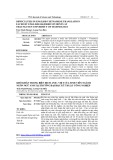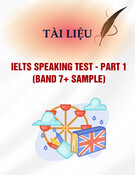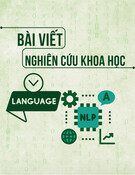
VNU Journal of Science: Education Research, Vol. 41, No. 1 (2025) 83-93
83
Original Article
Assessing the Current Situation of Teaching English
in Hanoi High Schools Towards Developing
Communication and Cooperation Skills: Perspectives
from School Managers, Teachers and Pupils
Nguyen Thanh Ly*
VNU University of Education, 144 Xuan Thuy, Cau Giay, Hanoi, Vietnam
Received 12th September 2024
Revised 19th Ferbuary 2025; Accepted 03rd March 2025
Abstract: This study aims to assess the current situation of English teaching towards developing
communication and cooperation skills at high schools in Hanoi. The research combines quantitative and
qualitative methods, including surveys and interviews with school managers, teachers, and pupils. The
results indicate many significant limitations in the teaching and learning process, including i) Lack of
diversity in learning methods and strategies; ii) Failure to create a positive attitude towards learning
English; iii) Ineffective integration of communication and cooperation content into the curriculum;
iv) Extracurricular activities such as English clubs are not organized regularly; v) Limitations in
applying modern teaching methods; vi) Lack of diversity in assessment methods; and vii) Limited
financial resources and teaching materials. The study suggests that there needs to be comprehensive
innovation in teaching methods, program content, and assessment methods, as well as resource
investment to improve the quality of English teaching and learning, meeting the requirements of the
2018 general education program and the practical needs of society.
Keywords: English teaching, communication skill, cooperation skill, high school, Hanoi,
educational innovation.
1. Introduction *
English proficiency has become
increasingly significant globally, particularly in
education. English has become a vital
component of the national curriculum in
Vietnam, especially in high schools. To align
_______
* Corresponding author.
E-mail address: lynt@vnu.edu.vn
https://doi.org/10.25073/2588-1159/vnuer.5203
with global educational trends emphasizing
competency-based learning, the 2018 General
Education Program introduced notable
pedagogical reforms to equip students with
essential communication and cooperation skills
[1]. In Hanoi, the capital and the center for
educational development, English teaching has
shifted focus towards developing crucial soft
skills and language proficiency that prepare
students to thrive in a globalized world. Moving

N. T. Ly / VNU Journal of Science: Education Research, Vol. 41, No. 1 (2025) 83-93
84
away from traditional rote learning, English
instruction now embraces more interactive and
participatory approaches that integrate
communication and collaboration skills, which
are vital in modern education. This paper
explores the objectives, content, teaching
methods, forms of assessment, and facilities for
English teaching in high schools in Hanoi,
emphasizing fostering communication and
cooperation skills under the 2018 General
Education Program framework.
2. Literature Reviews
Research strongly supports the transition
toward collaborative learning as an effective
method to enhance language acquisition,
particularly in the context of teaching English.
The 2018 General Education Program identifies
communication and collaboration as core
competencies for students [1]. Many studies
emphasize that communication involves
exchanging information, ideas, and emotions,
while collaboration entails working collectively
toward shared goals [ 2-4]. These skills are
critical for learners, enabling them to navigate a
rapidly changing society marked by global
connectivity and increased access to
information [5]
The increasing demand for English
language proficiency in our globalized
environment highlights the need for effective
language acquisition and communication skills
[6]. Numerous authors have identified essential
learning skills for the 21st century, including
critical thinking, problem-solving,
communication, collaboration, creativity, and
innovation [5, 7-10]. These soft skills are
integral not only for academic success but also
for expanding students' global social networks
and achieving success in extracurricular
activities [2]
Collaboration and communication are
central to survival and competitiveness in a
global context, as described by [11], who
situate these skills within the framework of the
4C model necessary for the 21st century.
Effective collaboration enhances efficiency,
while solid communication reduces participant
misunderstandings [11]. The partnership
between instructors and students and a clear
understanding of their respective roles in
blended learning environments is crucial for
fostering a productive learning atmosphere [12].
Through communication and collaboration,
practical social-emotional expressions
significantly enhance students’ sense of
ownership over their learning outcomes. They
reflect various levels of group dynamics,
including sharing, cooperation, and
collaboration [13]. Moreover, successful
collaboration in learning requires not only the
exchange of ideas but also increased cognitive
resources and interpersonal interactions, which
stimulate discussions and cultivate a shared
professional culture within educational
institutions [13].
Group work is essential for building the
collaborative communication skills necessary to
coordinate efforts to complete tasks. In contrast,
task-based work involves specific elements,
such as using tools and understanding processes
[14]. Graesser et al., [15] note that 21st-century
skills encompass self-regulated learning, team
problem-solving, and communication.
In conclusion, collaboration is a fundamental
principle for developing individualized education
plans and effectively implementing those plans in
practice [16]. Communication and collaboration
skills form the backbone of successful English
language teaching and learning in the modern
educational landscape.
3. Research Methodology
This study consisted of three data collection
phases, combining quantitative and qualitative
methods. The first phase was conducted by
exploratory interviews with several key
informants, aiming to provide information to
support the understanding of English teaching
in high schools in Hanoi towards developing
communication and cooperation skills to

N. T. Ly / VNU Journal of Science: Education Research, Vol. 41, No. 1 (2025) 83-93
85
implement the 2018 general education program.
This also provided the necessary information
for the survey in the next phase. Therefore, a
purposive sampling method was used to collect
quantitative data. The core sampling frame
comprised school managers and teachers
participating in the regular teacher training
program in implementing the 2018-2024
general education program. At the same time,
snowball sampling, based on these initial
contacts, generated additional subjects (school
managers, teachers) with respondents
suggesting names of pupils from their schools
who could be asked to participate in this study.
One hundred ninety-eight school managers,
English teachers, and pupils were recruited and
supported through a questionnaire survey
conducted by the researchers. This study was
conducted to ensure diversity in numbers. The
sample selection criteria were based on factors
such as the geographical diversity of districts in
Hanoi, teaching experience, and diversity in
teaching methods. The survey subjects were
53 managers, teachers (principals and
vice-principals: 18, officers from Hanoi
Department of Education: 03, teachers in
English: 32), and 145 pupils from 09 high
schools in Hanoi city (Table 1). The 09
surveyed schools include High School of
Educational Sciences, University of Education,
Vietnam National University, Hanoi, Nam Tu
Liem district; Chu Van An High School, Tay
Ho district; Phu Xuyen B High School, Phu
Xuyen district; Ngoc Tao High School, Phuc
Tho district; Thach That High School, Thach
That district; Quang Oai High School, Ba Vi
district; Nguyen Gia Thieu High School, Long
Bien district and Yen Lang High School, Me
Linh district. This method was used to collect
data related to the implementation of objectives,
content, methods, teaching forms, assessments
and facilities, and technical conditions serving
English teaching for high school pupils in the
direction of developing communication and
cooperation skills. The collected data were
processed on MS Excel and SPSS to evaluate
mathematical statistical parameters and create
tables. For calculating the mean score
(very good, good, acceptable, poor, very poor) on
the 5 Likert scale, scores were given for opinions
selected at the response levels, from 1 to 5 points
(in increasing order for selected opinions).
Then, 05 managers, teachers, and pupils who
participated in the survey using the
questionnaire were asked to participate in
subsequent interviews. This allowed for a
deeper exploration of critical questions such as:
i) What are the current limitations of testing and
assessing English? ii) Are communication and
cooperation contents integrated into English
lessons? iii) Have teachers used teaching
methods to support pupils in developing
communication and cooperation skills in
schools? iv) What are the difficulties in
teaching English to develop communication and
cooperation skills for teachers? v) Do you
participate in English clubs at school? These in-
depth, qualitative interviews allowed
respondents to clarify and discuss some
underlying factors that may not have been
identified in the quantitative model.
3. Results and Discussions
This study was conducted with the
participation of 198 people. In terms of gender,
there was a relatively even distribution, with
46.5% male and 55.6% female. Regarding
occupation, most participants were pupils,
accounting for 73.2%, followed by teachers
(16.2%), while management positions such as
principals and vice principals each accounted
for 4.5%.
The study was conducted in many districts
of Hanoi, with a fairly even distribution among
the areas. Ngoc Tao had the highest rate of
participants (12.6%), while Nam Tu Liem and
Thach That had the lowest rate (9.6%). The
diversity of locations and participants helped
the study comprehensively view the current
English teaching and learning situation in high
schools in Hanoi.

N. T. Ly / VNU Journal of Science: Education Research, Vol. 41, No. 1 (2025) 83-93
86
Table 1. Demographic information of respondents
Variables (n=198)
No
Percentage (%)
Gender
Male
92
46.5
Female
110
55.6
Job
Principal
9
4.5
Vice-principal
9
4.5
Teacher
32
16.2
Officer
3
1.5
Pupil
145
73.2
District
Nam Tu Liem
19
9.6
Tay Ho
23
11.6
Phu Xuyen
24
12.1
Ngoc Tao
25
12.6
Phuc Tho
21
10.6
Thach That
19
9.6
Ba Vi
21
10.6
Long Bien
20
10.1
Me Linh
23
11.6
Others
3
1.5
Survey results of the current situation of teaching English in Hanoi high schools towards
developing communication and cooperation skills:
Table 2: Implementing the goal of teaching English to high school pupils
in Hanoi City towards developing communication and cooperation skills
No
Items
School managers, teachers and pupils’ opinions
Very
good
Good
Acceptable
Poor
Very
poor
Mean
score
Standard
deviation
Rank
SL
%
SL
%
SL
%
SL
%
SL
%
1
Have basic
knowledge of
English, including
phonetics,
vocabulary,
grammar
60
30
55
28
41
21
37
19
5
3
3.65
0.11
3
2
Having
communication and
cooperation skills
through English
teaching activities
56
28
61
31
44
22
36
18
1
1
3.68
0.12
2
3
Use English as a
communication tool
58
29
60
30
46
23
33
17
1
1
3.71
0.12
1

N. T. Ly / VNU Journal of Science: Education Research, Vol. 41, No. 1 (2025) 83-93
87
4
Forming and
applying different
learning methods
and strategies to
develop
communication
skills in English
54
27
52
26
45
23
44
22
3
2
3.56
0.11
5
5
Having a positive
attitude towards the
subject and learning
English
59
30
59
30
34
17
40
20
6
3
3.63
0.11
4
Average
3.65
0.11
Table 3. Implementing English teaching content for high school pupils
in Hanoi City towards developing communication and cooperation skills
No
Items
School managers, teachers and pupils’ opinions
Very
good
Good
Acceptable
Poor
Very
poor
Mean
score
Standard
deviation
Rank
SL
%
SL
%
SL
%
SL
%
SL
%
1
System of
topics
(general),
themes
(specific)
62
31
53
27
47
24
33
17
3
2
3.70
0.12
1
2
Collaborative
competencies
related to topics
and themes
56
28
58
29
48
24
34
17
2
1
3.67
0.12
3
3
List of
language
knowledge
(phonetics,
vocabulary,
grammar)
61
31
50
25
52
26
33
17
2
1
3.68
0.12
2
4
Communication
skills related to
topics and
themes
59
30
55
28
44
22
38
19
2
1
3.66
0.11
4
5
Communication
and cooperation
content is
taught and
integrated in
the system of
topics and
themes
58
29
53
27
52
26
31
16
4
2
3.66
0.11
4
Average
3.67
0.12






![Đề cương môn Tiếng Anh 1 [Chuẩn Nhất/Mới Nhất]](https://cdn.tailieu.vn/images/document/thumbnail/2025/20251130/cubabep141@gmail.com/135x160/51711764555685.jpg)










![Mẫu thư Tiếng Anh: Tài liệu [Mô tả chi tiết hơn về loại tài liệu hoặc mục đích sử dụng]](https://cdn.tailieu.vn/images/document/thumbnail/2025/20250814/vinhsannguyenphuc@gmail.com/135x160/71321755225259.jpg)


